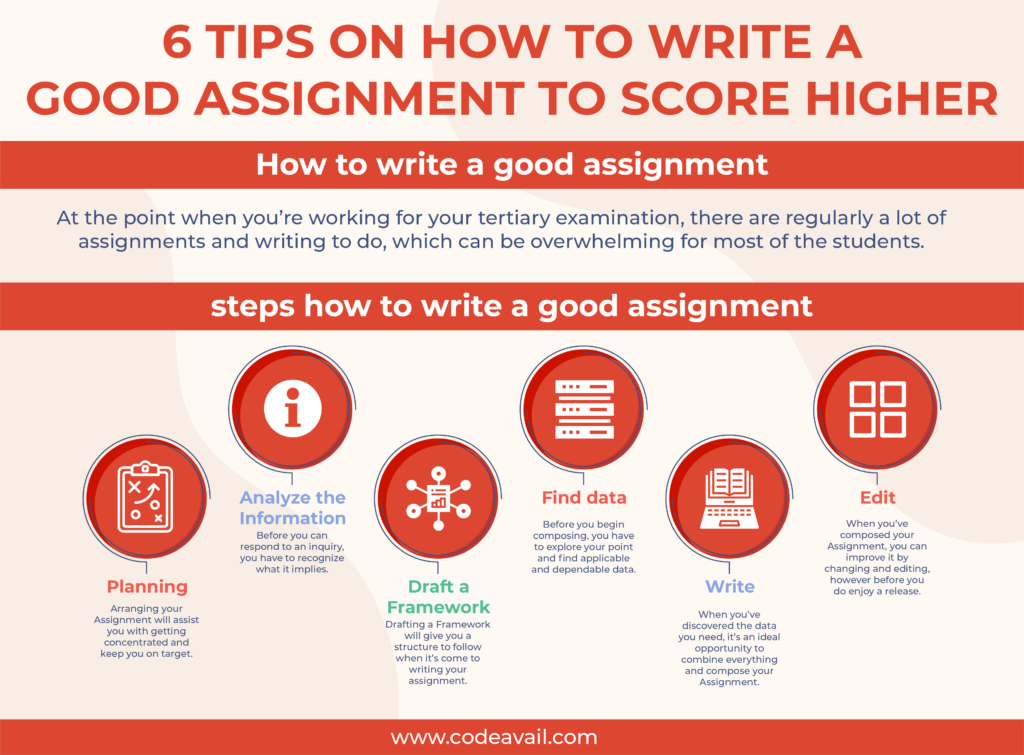Here in this blog, CodeAvail experts will explain to you 6 tips on how to write a good assignment to score higher step by step.
How to write a good assignment
Table of Contents
At the point when you’re working for your tertiary examination, there are regularly a lot of assignments and writing to do, which can be overwhelming for most of the students. The most significant thing to recall is to begin – and start early. Because that is the best thing you can do to get the best assignment and to get good grades.
In the event that you give yourself sufficient opportunity to work for your assignment, and to do your examination, compose and reconsider your Assignment you won’t need to hurry to fulfill your time constraint. Because that way only you will be able to complete your assignments on time and you will be able to submit it on time. When you’ve begun, you’ll additionally have something down on paper.

So, Essay Tigers specialist advises a few steps for you, that will be helping you with writing your assignments in the best way possible. So, that you can get the best out of it and get good grades. So, the steps are as follows:-
Step 1: Planning
Step 2: Analyze
Step 3: Draft a framework
Step 4: Find Relevant Information
Step 5: Write
Step 6: Edit
Time for us to discuss these steps how to write a good assignment:-
Step 1: Planning
- Arranging your Assignment will assist you with getting concentrated and keep you on target. Check how much your Assignment is worth and what level of the last imprint it is. This will assist you in choosing how much an ideal opportunity to spend on it.
- Check the marking schedule to perceive what your guide will be searching for when they mark your work and how the marks will be assigned to you in your assignment. This will enable you to comprehend what to concentrate on. In the event that there is no plan check the Assignment question to check whether the data is there for you to get good grades or not.
- Consider what you have to do to finish your Assignment (for instance, what research, composing drafts, reference checking, assessing and altering, and so forth). Split these up into a list of undertakings to do.
- Give each work a cutoff time, working in reverse from your Assignment due date.
Step 2: Analyze the Information
Before you can respond to an inquiry, you have to recognize what it implies. Peruse it gradually and cautiously, and attempt to comprehend what’s anticipated from you. Ask yourself:
- What’s the Information regarding? What’s the topic?
- What does the Information/question mean?
- What do you need to do?
To assist you with understanding the inquiry, take a step to convert it in your own words utilizing the arrangement beneath:
‘This Assignment is about ______________________ I have to___________________ ‘
At the point when you are investigating the inquiry:
- Search for words that guide you (instructional words). For instance, break down, analyze, differentiate, and so on.
- Check the significance of the words used.
- Search for subject words, which mention to you what you need to expound on.
- Search for restricting words, which limit the point and make it progressively explicit.
You can also check for extra data about the Assignment and what’s expected from you in the course materials. So that you can give your best after knowing what the requirements of the assignment are.
Tip: When you discover something about the Assignment on a course page or in a gathering save a duplicate of it. In the event that you spare all the data, you assemble about the Assignment in one document you will have all the data in a single spot when you begin composing.
Step 3: Draft a Framework
Drafting a Framework will give you a structure to follow when it’s come to writing your assignment. The kind of Assignment you are doing will give you a good structure to follow, however, you ought to also check the Information and marking plan, as they will assist you with seeing how the instructor anticipates that the topic should be organized, what must be incorporated, and which segments have the most weightage.
The greater part of the assignments you should do are divide into different parts, which for the most part follow a similar fundamental structure and that structure should be as follows:
- Intro (+ 10% of the Assignment) – This is the place you present the subject and the primary concerns, and quickly clarify the motivation behind the Assignment and your proposed result or discoveries. It is a smart thought to compose the presentation last with the goal that you comprehend what to incorporate.
- Mid / Discussion (+ 80% of the Assignment) – This area is isolated into various sections. Choose what concentrates you need to talk about and include another passage for every central matter. A section, for the most part, begins with a topic sentence expressing the fundamental thought, trailed by supporting proof and models. In your diagram attempt to incorporate draft topic sentences and a couple of thoughts describing what you need to remember for each area.
- End / Conclusion (+ 10% of the Assignment) – Conclusions quickly repeat your principal requirement and main argument, assess your thoughts, and sum up your decisions. They don’t present any new data.
Step 4: Find data
Before you begin composing, you have to explore your point and find applicable and dependable data. You will discover some in your course materials and suggested readings, yet you can also attempt:
- your neighborhood open library.
- conversing with specialists.
- online sources.
When you have found the relevant data, the next step will be to assess it to guarantee it is directly for your Assignment or not, if not then look out for other material.
Step 5: Write
When you’ve discovered the data you need, it’s an ideal opportunity to combine everything and compose your Assignment.
- Compose your first draft.
- Utilize your diagram and fill in the gaps, composing your primary concerns for each segment.
- Compose unreservedly, getting as much down as possible without struggling over the wording being 100% right.
- You may think that it’s simplest to begin with the end so you know which significance your composing is going for or the ground of your assignment. This means which way your assignment is going.
- The experience is frequently the hardest to write, so leave that till last.
- Try not to invest an excess of energy attempting to make this draft perfect.
- Revise your first draft, and watch that it is well and incorporates all that it needs to.
- Ensure you keep various copies of your drafts as you might need to return to them.
- Leave the composition for a day, read it, and adjust once more.
- Arrange your book reference or reference list.
- The most effective method to utilize APA referencing. So work as per the APA referencing.
Step 6: Edit
When you’ve composed your Assignment, you can improve it by changing and editing, however before you do enjoy a release. Indeed, even a brief break encourages you to get some good ways from your work so you can check your Assignment with an open-minded perspective.
Look at the bigger picture of your task, that what we have written and whatnot:-
- Have you responded to the Information you were set? Check your Assignment against the marking plan just as the inquiry.
- Is the structure right?
- Have you incorporated all the important parts? For instance, the cover sheet, presentation, end, reference list?
- Does your assignment read well, with each area streaming easily on to the following? A decent method to check this is to read it resoundingly.
- Have you utilized your own words and recognized every one of your sources?
- Is your Assignment an A-grade assignment?
- Have you utilized scholarly English (whenever required)?
- Check the language structure, accentuation, and spelling. Don’t simply utilize a spell checker (it won’t get everything).
- Check your referencing – have you recognized all work that isn’t your own? Is your APA referencing right?
- Are your pages numbered?
- Have you incorporated your name, understudy ID, the Assignment subtleties, and the date on each page?
Conclusion:
If conceivable, ask a companion or relative to edit your Assignment, as it very well may be hard to see botches in your own work.
Before you present your Assignment, print it out and check it one final time. It’s regularly simpler to spot blunders in print than on screen.
When you’re happy with your work, present your Assignment.
As a result, Our Computer Science Homework Help and Computer Science Assignment Help experts are available 24*7 to help you.

